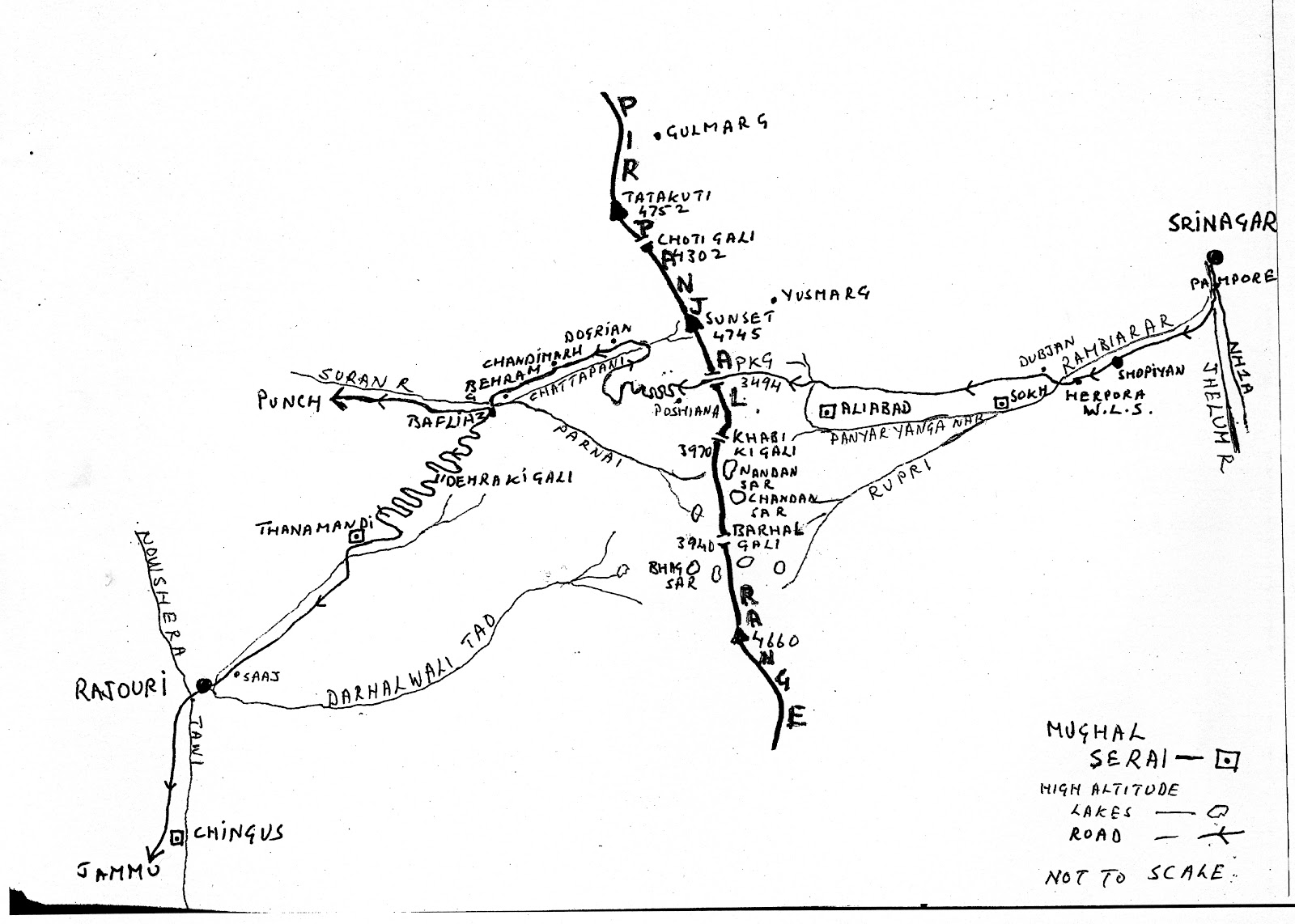The Pir Panjal Route:
The qafilas of the Gujjar-Bakarwals who follow the Pir Panjal Route start from their winter pastures in the third week of April and take about sixty days to reach the dhoks (summer pastures). Out of the sixty days, twenty-two are journey days and thirty-eight are halt days.
The qafilas start from Lamberi and making halts at suitable intervening pastures, they cross Sialsui, Kesargala, Dangri, Rajouri, Saj, Thana-Mandi and Neelideri.
At Neelideri, they stay for about two weeks and this period of stay is utilized for grazing in the surrounding intervening pastures. At this halt them, purchase the required goods, give salt to their flock, and repair their tools and equipments.
ADVERTISEMENTS:
From Neelideri, they move to Mara, Poshina, Chandimar and cross the stream of Chitta-Pani in which ice pieces flow in water. In this track, they face a lot of difficulties in fording the Chitta-Pani stream. At the occurrence of hails and rains, the flock faces great hardship.
From Poshina they move to Gadarmaidan, crossing the Mara-Chandimar, Posluana and Sathri Dubjan. It is in this tract where they cross the Pir Panjal Pass. Subsequently, from the Gadsar Maidan, they move to Sangerveni and then to Shalimar, situated to the north-east of Srinagar city on the bank of Dal Lake.
After staying for about two or three days at Shalimar, they commence their onward journey towards Wayl, Kangan, Wangat and Naranag. From Naranag, there is a steep ascend towards Gadsar. In fact, Gadsar pasture is the summer base for this qafila. During the summer season, they graze their sheep and goats in the dhoks (pastures) situated around Gadsar.
The Banihal Route:
ADVERTISEMENTS:
The second important channel through which the Gujjar-Bakarwals migrate from winter to summer pastures and back is the Banihal Pass route.
Around 20th April, they commence their journey from Kirangyal and its environs and up to the dhoks (summer pastures) they break journeys at twelve places. Friday or Monday is considered as the auspicious days for the upward or downward migration.
Starting from Kirangyal, they break their journeys at Manawal, Katta (Ladhadhar intervening pasture), Surinkund, Kabikhattar, Banihal, Dingunar, Achabal, Salar, Masitnar, Girwar, Chandanwari, Gabdalwa, Panjtarni and Sukhanala.
The journey between Khattar and Banihal in full of anxiety and tension between these two places, the flock is to travel on the National Highway No. 1. This is a continuous 23-hours journey. Being a very busy route, there is great fear of accidents, lack of fodder and animal lifters.
ADVERTISEMENTS:
This journey is broken at the Shaitani Nala (near Banihal) for one day rest after a long and hazardous journey. After crossing the Banihal Tunnel, the qafilas with their flock enter the valley of Kashmir. In their ascend they pass through Verinag, Aishmuqam, and finally reach the pastures of Daksum, Chandanwari and Sukhnala.
The return journey for the winter pastures (Siwaliks of Jammu Division) commences in the month of September. It is the period when night temperature in the summer pastures reaches close to the freezing point and the frequency of fog increases. The green pastures die out under the impact of frost and freezing night temperatures.
In such a situation the herds need protection from severe cold of the high altitudinal pastures. Consequently, the herdsmen start descending from the summer pastures. The return journey also consumes about sixty days which is broken at traditional paraos (halts).
Despite hazardous journeys, transhumance is a necessity for the Gujjar-Bakarwals. If these transhumant’s were to spend summers down on the outer hills of the Jammu region, the sheep and goats would die, if not of heat at temperatures of 40°C, than of starvation.
And if they were to attempt to spend winters in Gurez, Tilel, Matyana, Ringdoom, and Maru Wardwan on greater Himalayas 4,500 metres above the sea level, they would simply be buried under several feet of ice and snow.
